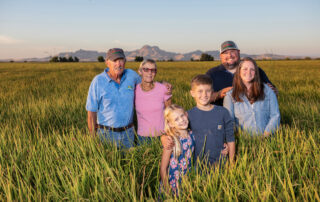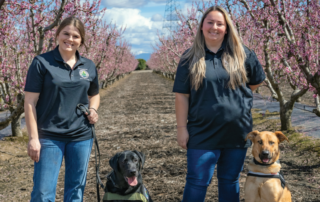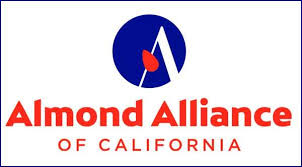Park Farming Organics Receives California Leopold Conservation Award
Courtesy of Sand County Foundation
Park Farming Organics of Meridian is the 2023 California Leopold Conservation Award® recipient.
The award honors farmers, ranchers, and forestland owners who go above and beyond in their management of soil health, water quality and wildlife habitat on working land.
Park Farming Organics’ owners, Brian and Jamie Park, and Scott and Ulla Park, were presented with the award during the California Farm Bureau Federation’s Annual Meeting. The Park family receive $10,000 and a crystal award for being selected.
Sand County Foundation and national sponsor American Farmland Trust present the Leopold Conservation Award to private landowners in 27 states. In California, the award is presented with Sustainable Conservation and the California Farm Bureau Federation.
Given in honor of renowned conservationist Aldo Leopold, the award recognizes farmers and forestland owners who inspire others with their dedication to environmental improvement. In his influential 1949 book, A Sand County Almanac, Leopold advocated for “a land ethic,” an ethical relationship between people and the land they own and manage.
Among the many outstanding landowners nominated for the award was finalist Bowles Farming Company of Los Banos in Merced County. Earlier this year, California farmers, ranchers and forestland owners were encouraged to apply (or be nominated) for the award. Applications were reviewed by an independent panel of agricultural and conservation leaders.
The California Leopold Conservation Award is made possible thanks to generous contributions from American Farmland Trust, Sustainable Conservation, California Farm Bureau Federation, Sand County Foundation, The Harvey L. & Maud C. Sorenson Foundation, Farm Credit, The Nature Conservancy in California, McDonald’s, and California Leopold Conservation Award alumni.
Scott and Ulla Park placed their bets on regenerative farming practices long before they were trending.
They spent the 1980s conventionally growing processing tomatoes before deciding to switch to organic production. Fueled by their love for agriculture and nature, coupled with a healthy dose of skepticism and common sense, they embarked on journey of exploration and discovery.
In their effort to mimic the natural world, the Parks chose gentler tillage methods, grew a variety of cover crops, and adopted a thoughtful rotation of crops. Their use of fertility inputs produced naturally balanced soils that help grow disease and pest-free plants. They noticed their once sterile soils became rich in earthworms and microbial life.
The Park’s farm, Park Farming Organics, grew to 1,350 acres, and is now run by their son Brian and his wife Jamie. What hasn’t changed is the family’s openness to experimentation and willingness to embrace new methods to adapt to changing consumer demands, market dynamics, environmental variability, and regulatory shifts.
Each year Park Farming Organics grows between 15-20 types of crops including rice, corn, wheat, sunflower, flax, alfalfa, barley, squash, cantaloupe, watermelons, cucumbers, and fresh market vegetables. It is governed by what the Parks call their “9 Cs of conservation”: critter cover, compost, controlled traffic, crop rotation, cover crops, conservation tillage, crop residue, conserving inputs, and crew care.
Their use of cover crops, compost applications, and crop residue annually returns an average of 15 tons of organic biomass per acre back to the soil. Growing sunn hemp as a cover crop helps improve soil properties, reduce soil erosion, conserve soil moisture, and recycle plant nutrients. The Parks’ unique border management of their fields includes growing diverse hedge rows that benefit wildlife and installing owl boxes to help control rodents.
Innovation and adaptability of farm equipment has been required to meet their production and conservation goals. Flotation tires on tractors help minimize compaction of rice fields. By modifying many core pieces of their farm equipment, the Parks have become leaders in developing specially adapted implements that other growers now rely on.
Exploring novel conservation practices has not been devoid of challenges and unexpected consequences. Scott and Brian participate in workshops, conferences, and fields days where they eloquently break down the challenges of organic and sustainable practices. Their expertise and willingness to share has made Park Farming Organics a go-to destination in northern California for students, scientists, journalists, and food sector professionals.
Collaborative partnerships with their local conservation district and universities have led to new innovations and provided regional context for adopting conservation practices. The impacts of their efforts to improve soil health are documented in a variety of peer-reviewed scientific journals. Promoting environmental stewardship among fellow farmers, educators, and environmental professionals is the purpose of the Parks’ involvement with the USDA Natural Resources Conservation Service’s Conservation Education and Awareness Center.
Through dedication, passion, and the ability to put their ideas into practice, the Parks have trailblazed a path for other farmers to begin their conservation journeys.
ACCOLADES
“We are honored to join Sand County Foundation, American Farmland Trust and Sustainable Conservation to recognize the extraordinary efforts of California farmers and ranchers who go above and beyond in their stewardship of our natural resources,” said Jamie Johansson, California Farm Bureau Federation President. “The Park family has championed organic and regenerative agriculture for decades. Their innovative and trailblazing spirit demonstrates the ability of California farmers and ranchers to find solutions for the environment while continuing to grow food that feeds the world.”
“The Parks define innovation and perseverance in California’s private land stewardship,” said Ashley Boren, Sustainable Conservation CEO, which has co-sponsored the award since its launch in California in 2006. “Caring for the soil, water, and air that nourish Park Farming Organics’ food crops is a full-time job. Brian, Jamie, Ulla and Scott go above and beyond that work with keen attention to how they’ll leave the land for future generations, how they can improve nutrition in the produce they grow, and how they can steward their precious water into the future.”
“As the national sponsor for Sand County Foundation’s Leopold Conservation Award, American Farmland Trust celebrates the hard work and dedication of Park Farming Organics,” said John Piotti, AFT President and CEO. “At AFT we believe that conservation in agriculture requires a focus on the land, the practices and the people and this award recognizes the integral role of all three.”
“These award recipients are examples of how Aldo Leopold’s land ethic is alive and well today. Their dedication to conservation shows how individuals can improve the health of the land while producing food and fiber,” said Kevin McAleese, Sand County Foundation President and CEO.

















